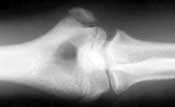Some young athletes’ shoulder, elbow problems may be prevented
Atlanta Brave’s team doctor offers tips on avoiding UCL injuries, Little Leaguer’s shoulder.
WASHINGTON — Shoulder and elbow injuries in adolescent athletes have increased in response to the tremendous popularity that youth baseball now enjoys worldwide. About 9 million U.S. children aged 6 to 17 years play baseball, according to Joseph B. Chandler, MD, of Atlanta. This, coupled with the trend for children to play on multiple baseball teams simultaneously, means orthopedists are seeing and treating overuse injuries more often.
Unfortunately some injuries, like osteochondritis dissecans (OCD) and ulnar collateral ligament (UCL) injuries, can be career ending.
The orthopedic surgeon, however, can play a key role in reducing these injuries by educating athletes, parents, coaches and youth sporting organizations in their community about causes and prevention, Chandler said. The information he provided to attendees at the American Academy of Orthopaedic Surgeons 72nd Annual Meeting might affect the patients they see and “truly make an impact on the adolescent athlete, particularly the adolescent baseball player,” he said.
Chandler is team doctor for the Atlanta Braves baseball team.
Rest recommended
Resolving nearly all of these injuries requires rest, Chandler said. “If you think they’ve rested enough, they need to rest more.” Returning to play before symptoms have resolved can be damaging. It typically takes three to six months until a young pitcher with a condition like Little Leaguer’s shoulder becomes symptom-free, he said. “You do not have to wait until X-rays return to normal because they take even longer than symptoms do to resolve.”
Chandler described Little Leaguer’s shoulder as an indeterminate condition. Clinicians see it more frequently in states like Texas, California and Florida that have year-round baseball programs, 80% of the time in pitchers. Little Leaguer’s shoulder is described variously as a stress fracture of the proximal humeral physis, epiphyseolysis or osteochondrosis.
“The common thread is the high volume of throwing, overuse and abuse of these young athletes,” Chandler said, noting that patients present with pain in their dominant throwing shoulder and proximal humeral physeal widening on radiographs. “About 52% will have fragmentation of the physis.”
Laying off a season typically provides sufficient rest for symptom resolution.
A big problem
|
|
Another all-encompassing term — Little Leaguer’s elbow — includes such problems as ulnar neuritis; stress fractures of the olecranon; medial epicondylar traction apophysitis or avulsion; UCL injuries; and lateral compression overload syndromes, including Panner’s disease or osteochondritis dissecans. “It’s amazing the number of kids who have elbow complaints,” Chandler said, citing one series where 20% of 11- and 12-year-olds complained of elbow problems.
During the physical exam and history, orthopedists should look for signs of overuse in children who play on multiple or all-star teams. Such overuse often causes flexion contractures to 10° to 15°. Chronic radiographic changes are common, such as widening of the medial epicondylar physeal line with or without fragmentation of the epiphysis.
Rest is the common denominator of treatment in Little Leaguer’s elbow.
“You’ve got to treat this very conservatively and give them adequate time off.” If untreated or unrecognized, these overuse conditions may lead to irreversible changes.
Adolescent pitchers with chronic lateral compression overload may develop OCD of the capitellum, a focal osteonecrosis with varying degrees of subchondral separation leading to a propensity for loose body formation and, often, a poor prognosis.
Various treatments exist, but Chandler recommended conservative treatment if it is a stage 1 lesion and the subchondral bone is not displaced as seen on imaging. These young athletes should not be allowed to pitch for at least one year, but they “may be able to return to play another position when symptoms completely resolve, which usually requires three to six months.”
Stages 2 and 3 of OCD involve varying degrees of subchondral bone separation, frequently involving loose body formation. Separated fragments heal poorly and debridement and drilling are often necessary. Prognosis is poor at returning these kids to competitive pitching.
|
||||||||||||||||||
|
Courtesy of Joseph B. Chandler |
||||||||||||||||||
UCL injury affects careers
“We’re seeing younger and younger kids who are injuring their UCL,” Chandler said. Acute or chronic valgus extension overload constitutes the mechanism of injury. “More than 90% involve some chronic damage, overuse attenuation of the UCL.” Chandler recommended conservative treatment if the symptoms and attenuation are mild and the ligament is partially torn. But “if there’s significant medial joint line opening on stress X-rays or MRI documents complete tearing of the UCL, prognosis is poor with nonoperative treatment if the athlete wishes to continue to pitch on a competitive level.”
Often the best option for the adolescent pitcher with a serious injury to the UCL invovles involves moving the baseball player to another position permanently. “The likelihood of an adolescent or high school pitcher having a UCL reconstruction and advancing beyond this level is not very good. So if he’s a great baseball player, we need to be realistic and … say, maybe it’s time to change positions or even change sports.”
For more information:
- Chandler JB. The epidemic of arm injuries in the adolescent pitcher: Is prevention possible? ICL#211. Presented at the American Academy of Orthopaedic Surgeons 72nd Annual Meeting. Feb. 23-27, 2005. Washington.

